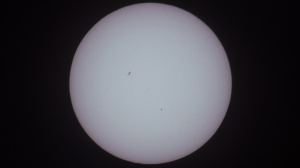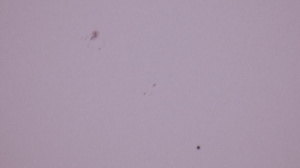Well I haven’t blogged anything in ages, and I’ve moved to the pacific northwest where I’m not likely to get the same amount of opportunities to use my solar scope as I did in southern California.
New Horizons and Pluto
It’s all good though because this summer we’ve got some great activity in the solar system. Like most people, when I was a kid, Pluto was a planet. This exotic place farther from our Sun than any other in the solar system. Pluto’s been demoted, but it hasn’t diminished in my mind.
Observing Pluto with amateur telescopes is not very exciting. Pluto is so small and far away that you can’t really tell the difference between Pluto and a star. I was observing once with a friend who had an 8″ Celestron Ultima 2000 SCT. These telescopes are computerized, and he wanted to look at Pluto. So he told the computer, “show me Pluto.” After the whirring of the motors stopped, we looked in the eyepiece to a what appeared to be a field of stars. We joked that the only thing we knew was that light reflected from Pluto had entered our eyes. Had we had detailed star charts we would have been able to figure out which speck of light was Pluto, but Pluto is so dim that I don’t think there’s a chart on the market we could have purchased. We would have had to make a chart with our computer and print it out.
Anyway, the point of this post is to talk about the NASA New Horizons mission. The JPL page for the mission is here. After nearly 10 years flying out to Pluto, New Horizons is starting to get close. It will pass nearest to Pluto on July 14th before going on to explore the Kuiper Belt. It’s starting to return photos that are better than anything we’ve taken before, and there only going to get better for the next month. This is so exiting. Not only are we going to learn a lot about Pluto, but we will undoubtedly end up with a lot more new questions about Pluto and the formation of our solar system.
My favorite image so far is this animation that shows the odd orbit of Pluto and its largest moon Charon. Charon’s mass is 11.6% that of Pluto. We’re used to seeing one object orbit another with much larger mass, so the effect of the smaller object on the larger object is not easily detectable. However, in this case, it is very obvious that Charon is tugging on Pluto in a very large way. Both objects orbit around a point in space instead of a point inside Pluto!

Pluto and Charon orbiting a point between both objects.
Dawn and Ceres
At the same time NASA’s Dawn mission is in orbit around Ceres the largest object in the asteroid belt. Some amazing photos of this object have already been returned. Why not pop over to JPL’s page and have a look.
Rosetta and Comet 67P/Churyumov–Gerasimenko
This one’s been in the news quite a bit lately because earlier this year there was a bit of problem with the Philae lander that was launched from Rosetta. Philae was supposed to decent from orbit, land and anchor itself on the comet to investigate up close. However, there was a problem with the landing, and Philae didn’t get anchored. It’s been without power because its solar cells were shaded until just a few days ago, but its getting enough power to operate again now that the comet is closer to the Sun.
The Planetary Society has a page with very cool 3-D images of the comet. Here is the European Space Agency media gallery for 67P.



